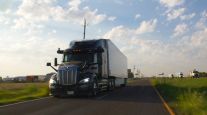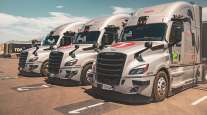iTECH: ‘Self-Driving’ Trucks Inch Closer
This story appears in the December 2013/January 2014 issue of iTECH, published in the Dec. 16 print edition of Transport Topics. Click here to subscribe today.
By Roger W. Gilroy, Contributing Writer
Consumers worldwide say they want to experience self-driving vehicles as automakers roll out an increasing number of cars that can take over and drive themselves, using mathematical calculations, an array of sensors and electronic controls of key vehicle systems. Nissan has promised consumers a fully autonomous car by 2020. And some predict the same technology eventually will transform commercial trucking.
Already, the U.S. military — which has experimented with self-driving truck convoys — has joined in a new effort with some fleets, truck makers and regulatory agencies to explore ways to lower the cost of the technologies that enable self-driving vehicles and pioneer their use in commercial fleets.
However, Brad Templeton, an adviser to the Google team that developed that company’s fleet of self-driving cars, which have logged hundreds of thousands of real-world miles, said it was appropriate for cars to lead the way.
“I don’t want to pretend to truckers that their profession isn’t going to see big changes,” he said, “but they will come a bit later. In the long term, it will be mostly automated, once people are satisfied it’s safe. There will still be [truck] drivers for special situations, like a harbor pilot perhaps, but fewer of them.”
The National Highway Safety Administration, citing the simultaneous development of advanced driver assistance systems, vehicle-to-vehicle and vehicle-to-infrastructure communications and self-driving vehicles said recently that the United States “is on the threshold of a period of dramatic change in the capabilities of, and expectations for, the vehicles we drive.”
Software manufacturer Cisco Systems said a recent survey it conducted showed that a majority of people say it’s likely they will ride in a car that doesn’t need a human driver and that 48% of those people indicated they would trust such a car to transport their children.
On the commercial side, the military, trucking interests and government agencies have begun collaborating in what is being called the Fleet Automation Forum, said Mohammad Poorsartep, who is coordinating the effort for the Connected Vehicle Proving Center at the University of Michigan-Dearborn.
Poorsartep told iTech the idea for the forum emerged from a meeting between representatives of the university and the U.S. Army’s Tank Automotive Research, Development and Engineering Center, or Tardec. The aim is to pursue autonomous driving in the same way that the military and trucking worked together, he said, to develop and commercialize hybrid electric motors about a decade ago.
“Tardec is interested in doing the same thing with automation technology,” Poorsartep said.
The National Defense Authorization Act of 2001 required advances in “unmanned, remotely controlled technology such that, by 2015, one-third of the operational ground combat vehicles are unmanned.”
Ultimately, the direction the forum takes depends on the “[best]-use case for the [autonomous] technology. We need to have the fleet industry on board to learn what are their requirements,” Poorsartep said. “At this point, they are sitting here saying, ‘Well, we can platoon these linehaul delivery trucks going interstate routes so we can reduce fuel costs and improve safety.’ But this may not be the use case the industry is [actually] looking for.”
Oshkosh Corp., of Oshkosh, Wis., developed technology called TerraMax UGV to provide a driverless option for some of the military trucks it builds, including those that haul troops and pull howitzers, and larger ones that can carry bridge parts. It said it envisions the same technology being included on some of its specialty commercial trucks.
John Beck, Oshkosh’s chief engineer for unmanned systems, told iTech that electronic stability-control braking systems, radar-based sensors, adaptive cruise control and collision-mitigation braking, available on many consumer and commercial vehicles, “are some of the same technologies found in our drive-by-wire kit, which enables the actuation of the [military] vehicle.”
“We are cognizant,” Beck said, “of how we could apply this technology in our other business segments. For example, we could use it on the Oshkosh Airport Products brand, including snow trucks or fire-fighting vehicles to provide safer and more efficient operations.”
Dominique Bonte, a vice president with London-based market analysis firm ABI Research, told iTech, “An appropriate [connected-vehicle] mandate would create dynamics in this market that we really need” to move it beyond research.
Francine Romine, spokeswoman at the University of Michigan Transportation Research Institute in Ann Arbor, Mich., which has been conducting a connected-vehicle test, said she expects a mass deployment of connected-vehicle devices through the aftermarket.
“It’s great to have everyone out there talking,” she said. “Connected vehicles are the necessary foundation to get to automated vehicles down the road.”
There have been other recent developments, too, in advanced driver-assistance systems for the commercial sector.
Bendix Commercial Vehicle Systems, in Elyria, Ohio, said that its next-generation, commercial-vehicle collision-mitigation system is in full development with key supplier partners, including TRW and Mobileye, and will be available exclusively through major truck manufacturers.
Bendix’s new system will use “a TRW camera that has been adapted for use by Bendix. The camera is powered by the Mobileye System-on-Chip EyeQ2 processor with state-of-the-art vision algorithms,” the company said. The system will “automatically apply brakes based on combined radar-vision input.” Bendix’s current collision-mitigation system is called Wingman and is radar-based.
“We are definitely well down the launch path, but I am not at liberty to share any more info at this point,” Barbara Gould, the company’s communications director, told iTech in September.
Also, Meritor Wabco, based in Troy, Mich., said the next generation of its OnGuard collision-mitigation system, which includes partial braking capability on detection of stationary objects, will be in production by Wabco in January 2014 in Europe, followed by a North American introduction by the joint venture in mid-2014.
It will feature a “77 GH radar system, able to provide the longest, widest detection range with the greatest accuracy.”
Meritor Wabco added that UMTRI had studied forward collision avoidance and mitigation technology in operation and concluded it significantly reduces the probability of rear-end striking crashes in realistic operating conditions when installed on tractor-semitrailers and single-unit trucks.
“There is a lot of speed behind an awful lot of this stuff,” said Ted Scott, director of engineering and safety at American Trucking Associations. Scott speculated that pure economics could persuade fleets to change to autonomous trucks given the ongoing expense associated with hiring, employing and retaining drivers.
But Scott wouldn’t try to predict when that might happen. “I think five years is too optimistic, and I can’t look out 25 years, not in this environment, and be able to predict.”




